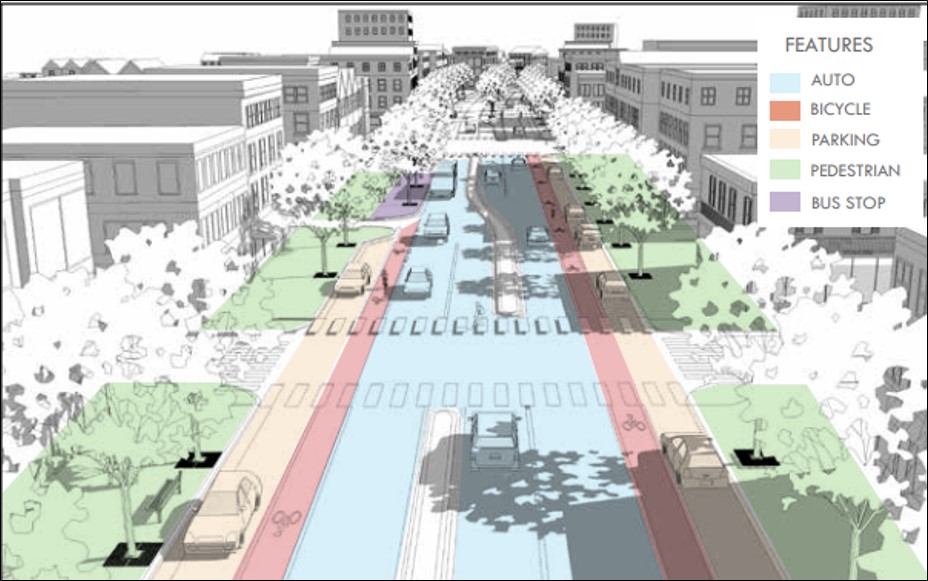In early October, the West Piedmont Complete Streets Coalition re-engaged after an approximate two-year hiatus. Unlike past years, when the Coalition met in the office of the West Piedmont Planning District Commission, this meeting was held virtually, via video conference. On this virtual platform, the Coalition worked to catch up generally where it had left off two years ago.
The West Piedmont Complete Streets Coalition was formed during fall 2015, as an element of Go Healthy West Piedmont, which was a grant-funded initiative within the West Piedmont Health District (consisting of Franklin, Henry, and Patrick counties, as well as the City of Martinsville) to prevent chronic health conditions such as diabetes, obesity, and heart disease. The initiative, administered by the Virginia Department of Health, was funded with a CDC 1422 grant.
During the years immediately following the creation of the Coalition, activities typically included meetings to discuss aspects of and ways to implement Complete Streets. The heart of the effort, however, involved a series of walkability audits in localities throughout the Health District. Walkability audits could be described as evaluating road segments for pedestrian comfort. Are there sidewalks? If so, what is their condition? Does it feel safe to walk here? Are there benches? These walkability audits culminated in the West Piedmont Complete Streets Walkability Assessment Report, written by a Virginia Tech intern who was involved with Go Healthy West Piedmont. The report compiled all of the walkability audits by locality and articulated the needs and recommendations that were developed as a result of these audits. This report was recently used as a supporting document for a transportation application seeking funding to construct a sidewalk in the Town of Stuart. The West Piedmont Complete Streets Walkability Assessment Report is available at http://www.wppdc.org/transportation-planning/complete-streets. The CDC 1422 grant period ended in 2018, resulting in the temporary hiatus.
Before I go any further, let me explain what Complete Streets are. Complete Streets are streets that are designed for all users to include drivers, pedestrians, bicyclists, and transit riders (where applicable). In an urban context, a Complete Street is often a street with vehicular travel lanes, sidewalks, bike lanes, and possibly bus stop shelters and bus pull-out areas. In a rural or suburban environment, by contrast, a Complete Street may simply be a rural road with paved shoulders designated to be used as bike lanes.

This image, obtained from the DRPT Multimodal System Design Guidelines (updated March 2020), shows an example of a Complete Street in an urban context.
The Complete Streets virtual meeting this past week started out by reviewing activities of the West Piedmont Complete Streets Coalition during its formative years. Next, a lengthy list of accomplishments pertaining to improving pedestrian and bicycle infrastructure in the region took place. This was followed by a discussion of pedestrian and cycling needs throughout the region, which was followed by a brief discussion of next steps. Meeting attendees included local planning directors and other municipal staff, a Virginia Department of Health representative, a representative of a health insurance company, a disability advocate, a VDOT planner, West Piedmont Planning District Commission staff, and a local mobility manager. Representatives of the Harvest Foundation, which is an organization that serves Martinsville and Henry County by providing grants for initiatives pertaining to education, health, and vitality of the community, also attended. The Coalition plans to meet again in the future, possibly in early December. And unlike the Coalition’s strict adherence to the boundaries of the West Piedmont Health District as part of Go Healthy West Piedmont’s CDC grant, the initiative can now encompass more of the Planning District.
Complete Streets have can provide numerous benefits to a locality. Possibly the most obvious is that they facilitate a multimodal transportation system, enabling people to use means of travel besides the automobile, such as travel by foot or by bicycle. Second, since Complete Streets encourage active transportation (walking and biking), they present a community’s citizenry with opportunities to remain active, and thereby can help reduce chronic health conditions such as diabetes, obesity, and heart disease. In another context of public health, Complete Streets can serve as a means of socially-distant commuting for those workers who live close to where they work, in particular. Fourth, Complete Streets can serve as a catalyst for local economic development by promoting foot and bike traffic in a community, thereby bolstering patronage of local businesses. They can also encourage investment by helping to “spruce up” an area and promote use of public space, which can, in turn, lure businesses and residents. Additionally, younger and older generations, such as Millennials and retirees, respectively, increasingly prefer to relocate to communities having multimodal transportation systems. Lastly, Complete Streets have been demonstrated to improve roadway safety. In the Town of Amherst, Virginia, for instance, the town’s main street had undergone a road diet, which means that one or more travel lanes were eliminated, and, supplanting the travel lane(s), bike lanes and on-street parking were added. The result has been a crash reduction of about 50 percent over a three-year period.
If you live near a Complete Street and reside close to where you work or shop, you can earn points toward rewards by simply downloading the RIDE Solutions app for free and logging your trips. By doing so, you’ll earn discounts on food, shopping, and entertainment. Download the app today at ridesolutions.org!


